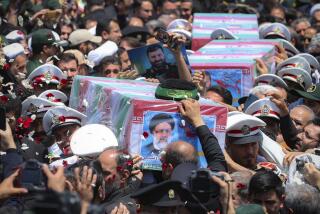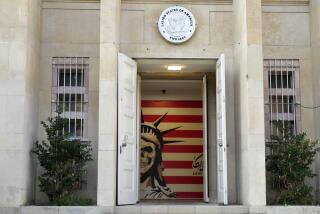Khomeini : Iran Leader Vilified in Iraqi City Where He Built Revolution
- Share via
NAJAF, Iraq — Ayatollah Ruhollah Khomeini slept here.
And prayed, and waited.
There is no plaque on the wall to commemorate his stay, though. And residents say they would tear him to pieces with their bare hands if he ever came back.
For 14 years, Najaf, a dusty Islamic holy city, was the base from which the elderly Iranian exile slowly built a movement that overthrew the world’s oldest monarchy.
Bitter memories are all that Najaf has left for its once-honored guest, who during his years here nurtured an anonymous exile into worldwide fame and a fundamentalist revolution that brought down the U.S.-backed Shah Mohammed Reza Pahlavi of Iran.
School Shuttered
Today, his religious school is shuttered, his few followers ostracized. Refugees from Iranian artillery attacks on the southern port city of Basra live in his house.
“I remember that he was an old man, with a big gray beard, black turban, sometimes alone or with friends from Iran,” said Sheik Thamin el-Mayahi, a member of Najaf’s religious committee. “He rarely spoke to any of us (Iraqis). He was a loner--sad, unhappy and very gloomy.
“If I saw him here today, I would tear him to pieces with my bare hands and teeth. Everyone must kill him and throw his body in mud.”
“I helped protect him here,” said a local security officer who declined to give his name. “We escorted him when he walked around and also guarded his house in case any of the shah’s agents attempted to kill him.
“If I had known then what I know now, I would have taken out my pistol and shot him dead myself.”
Betrayed by Khomeini
The source of this vehement hatred--publicly shared by all in Najaf who knew him--is the conviction that Khomeini betrayed Iraq, which gave him asylum from 1965 to 1978, four months before he returned in triumph to Tehran.
Najaf has for 14 centuries been the world’s most respected center of Shia Muslim teaching and a shrine visited by millions of Shia pilgrims.
It was from Najaf, overlooking palm tree orchards on the edge of a desert that stretches to Syria and Jordan, that Khomeini laid the foundations for his revolution.
His brief stay in a Paris suburb before arriving in Tehran on Feb. 1, 1979, is better known than the many years in Najaf, 100 miles south of Baghdad. But it was Iraq that gave Khomeini the springboard to mobilize his Muslim forces.
2 Big Mistakes
The two biggest mistakes that Iraqi President Saddam Hussein ever made, many who follow the Middle East say, were allowing Khomeini to leave alive and then starting a war with him.
“But how were we supposed to know he would turn out so bad?” El-Mayahi asked. “He came here out of the generosity of Iraq and our great President Saddam Hussein. But he was a devil and tricked everyone.”
The religious leaders of Najaf also feel cheated, because Khomeini has built Iran’s own holy city of Qom into what is today considered the leading center for Shia religious study.
Najaf’s clerics dispute this, saying their city still has 351 Shia schools, each with as many as 600 students and 500 mosques. But Qom has become the home of most high-ranking Shia religious leaders.
Shocked by Turkey
Khomeini, sent into exile from Iran on Nov. 4, 1964, was shocked by the secular nature of life in Turkey, his first exile home. He was granted asylum by Iraq and arrived in Najaf in January, 1965.
Authorities reportedly believed that just one more Shia teacher in the holy city would cause few ripples. By then, Khomeini was widely considered an impoverished, sick man and a spent force against the might of the shah.
The 64-year-old ayatollah, his wife and two sons rented a dusty, mud-brick house 200 yards from the shrine of Imam Ali--the man that Shias believe was the true successor of Islam’s prophet Mohammed, who died in AD 632 in Medina.
Khomeini’s house still stands at 27 Al-Ehwash St., its enclosed wooden balcony hanging over the street, shading a door with an unpolished brass knocker and peeling with dark red paint. The family living there now fled Iranian artillery guns raining shells near their home in Basra.
Khomeini’s Home
“Of course we are happy that we live in Khomeini’s house,” Kassim Mohammed, 14, said, standing in the doorway. “It feels much like any other house, but Khomeini can’t have it back.”
What used to be Khomeini’s reception area, a gloomy room with cracked, pale blue walls, now holds a refrigerator and mats for Mohammed’s family to sleep on. It was in this room that the ayatollah, sitting cross-legged and characteristically staring at his toes, listened to news brought by secret Iranian emissaries and ordered the next move against the shah.
His neighbors in the low-income neighborhood remember him as a gaunt man who walked between the mosque or his school without greeting them.
“I don’t think he spoke very good Arabic,” the owner of a nearby cafe said. “He never came in here, but his servant would come by from time to time buying food for the house. They never spent very much money.”
Rebuked for Killing Flies
Najaf’s narrow streets are each halved by an open drain down the middle. Its overcrowded market area is foul-smelling and swarming with flies.
Khomeini’s younger son, Ahmad, once told reporters how his father rebuked him for killing the flies that made life there so unpleasant, saying that even flies were created by God.
It was Ahmad who made handwritten copies of the letters his father dictated for Tehran newspapers, until Najaf got a duplicating machine.
Khomeini spent most of each day inside praying and reading. But he would sometimes leave shortly before noon and walk the 200 yards past chicken butchers, shoemakers and food shops to the tiny Al-Ensari mosque.
Students Avoid Mosque
“Unlike most others, he didn’t care about Friday being a special day of prayer,” Sheik el-Mayahi said. “He said every day should be Friday for a Muslim, so he wouldn’t go anywhere special to pray.
“He would only go to the shrine of Imam Ali when he wanted to meet people and be seen.”
The 50 Iranian religious students stranded in Najaf since the start of the Iran-Iraq war nearly seven years ago avoid the Al-Ensari mosque. They declined to talk about the ayatollah.
“No Iraqis pray with them,” El-Mayahi said. “As they are sick inside because of Khomeini, they study, eat and pray alone.”
Slowly Built Following
Khomeini, shunned by the other grand ayatollahs of Najaf, timed his trips to the shrine so that he would not encounter them. But he slowly built up his own following.
By 1972, Khomeini could afford to buy a newer and larger house and was lecturing to students at the Iranian-owned school of Al-Tabatabae Al-Boregrde, 50 yards from the main entrance to the shrine.
The school has been locked since Khomeini left Najaf for Paris in 1978. Its windows are covered with dust, and the blue-and-white tiled sign over the door is chipped and caked with dirt.
“The government will not change it because it is religious,” El-Mayahi said. “But no student goes there now because of Khomeini.”
Considered a Fraud
Officials in Najaf said they did not know of any Iraqi followers of Khomeini. But any link with the ayatollah now would be regarded as treason. Today, Iraqi Shias call him a fraud.
“Khomeini lived here for 14 years but was a cheat and tried to convince the people he was everything,” the security officer said.
But back in 1972, Hussein’s ruling Baath Party, already on the verge of war with Iran, gave Khomeini time on Baghdad Radio to beam propaganda attacks at the shah.
By 1977, Khomeini was escalating his calls for the overthrow of the shah. Hundreds of Iranians began making pilgrimages to Imam Ali’s shrine in Najaf, where Khomeini led prayer sessions and unleashed blistering sermons attacking the shah as an anti-Islamic puppet of both Washington and Israel.
Proof of Popularity
His sermons were taped and distributed through Iran and helped to quickly swell the ranks of his supporters, establishing him as the undisputed leader of anti-shah activities in exile. Proof of his popularity came when thousands turned out for memorial services in Tehran after his eldest son, Mostafa, died.
Khomeini’s growing strength finally became too much even for authorities in Baghdad, who had rigorously suppressed Iraqi Shia fundamentalists. In September, 1978, they demanded that he leave. Khomeini was escorted out of Najaf and, having been refused entry by Kuwait, flew from Baghdad to Paris.
Najaf--along with the holy city of Karbala, where Khomeini also worshiped--has become a rallying point for Iranian soldiers, targeted by the ayatollah for liberation.
“We never saw him, and if he wants to come here again, this time as an invader, we will kill him,” said Sayeed Adeel al-Tuama, custodian of the city’s shrine.
More to Read
Sign up for Essential California
The most important California stories and recommendations in your inbox every morning.
You may occasionally receive promotional content from the Los Angeles Times.













